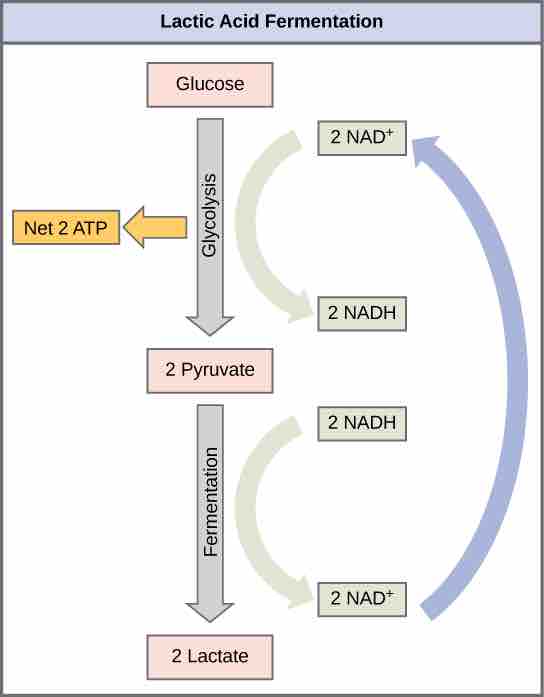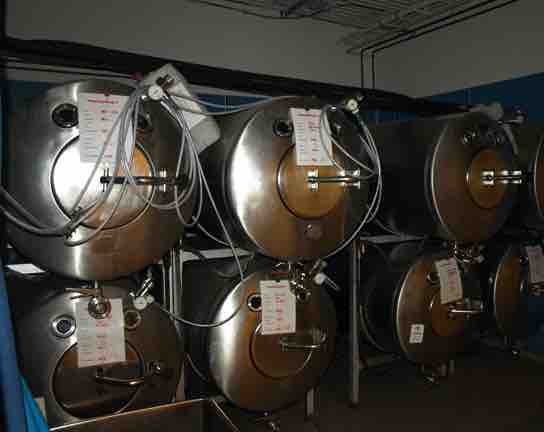Anaerobic Cellular Respiration
The production of energy requires oxygen. The electron transport chain, where the majority of ATP is formed, requires a large input of oxygen. However, many organisms have developed strategies to carry out metabolism without oxygen, or can switch from aerobic to anaerobic cell respiration when oxygen is scarce.
During cellular respiration, some living systems use an organic molecule as the final electron acceptor. Processes that use an organic molecule to regenerate NAD+ from NADH are collectively referred to as fermentation. In contrast, some living systems use an inorganic molecule as a final electron acceptor. Both methods are called anaerobic cellular respiration, where organisms convert energy for their use in the absence of oxygen.
Certain prokaryotes, including some species of bacteria and archaea, use anaerobic respiration. For example, the group of archaea called methanogens reduces carbon dioxide to methane to oxidize NADH. These microorganisms are found in soil and in the digestive tracts of ruminants, such as cows and sheep. Similarly, sulfate-reducing bacteria and archaea, most of which are anaerobic, reduce sulfate to hydrogen sulfide to regenerate NAD+ from NADH.

Anaerobic bacteria
The green color seen in these coastal waters is from an eruption of hydrogen sulfide-producing bacteria. These anaerobic, sulfate-reducing bacteria release hydrogen sulfide gas as they decompose algae in the water.
Eukaryotes can also undergo anaerobic respiration. Some examples include alcohol fermentation in yeast and lactic acid fermentation in mammals.
Lactic Acid Fermentation
The fermentation method used by animals and certain bacteria (like those in yogurt) is called lactic acid fermentation. This type of fermentation is used routinely in mammalian red blood cells and in skeletal muscle that has an insufficient oxygen supply to allow aerobic respiration to continue (that is, in muscles used to the point of fatigue). The excess amount of lactate in those muscles is what causes the burning sensation in your legs while running. This pain is a signal to rest the overworked muscles so they can recover. In these muscles, lactic acid accumulation must be removed by the blood circulation and the lactate brought to the liver for further metabolism. The chemical reactions of lactic acid fermentation are the following:
Pyruvic acid + NADH ↔ lactic acid + NAD+

Lactic acid fermentation
Lactic acid fermentation is common in muscle cells that have run out of oxygen.
The enzyme used in this reaction is lactate dehydrogenase (LDH). The reaction can proceed in either direction, but the reaction from left to right is inhibited by acidic conditions. Such lactic acid accumulation was once believed to cause muscle stiffness, fatigue, and soreness, although more recent research disputes this hypothesis. Once the lactic acid has been removed from the muscle and circulated to the liver, it can be reconverted into pyruvic acid and further catabolized for energy.
Alcohol Fermentation
Another familiar fermentation process is alcohol fermentation, which produces ethanol, an alcohol. The use of alcohol fermentation can be traced back in history for thousands of years. The chemical reactions of alcoholic fermentation are the following (Note: CO2 does not participate in the second reaction):
Pyruvic acid → CO2 + acetaldehyde + NADH → ethanol + NAD+

Alcohol Fermentation
Fermentation of grape juice into wine produces CO2 as a byproduct. Fermentation tanks have valves so that the pressure inside the tanks created by the carbon dioxide produced can be released.
The first reaction is catalyzed by pyruvate decarboxylase, a cytoplasmic enzyme, with a coenzyme of thiamine pyrophosphate (TPP, derived from vitamin B1 and also called thiamine). A carboxyl group is removed from pyruvic acid, releasing carbon dioxide as a gas. The loss of carbon dioxide reduces the size of the molecule by one carbon, making acetaldehyde. The second reaction is catalyzed by alcohol dehydrogenase to oxidize NADH to NAD+ and reduce acetaldehyde to ethanol.
The fermentation of pyruvic acid by yeast produces the ethanol found in alcoholic beverages. Ethanol tolerance of yeast is variable, ranging from about 5 percent to 21 percent, depending on the yeast strain and environmental conditions.
Other Types of Fermentation
Various methods of fermentation are used by assorted organisms to ensure an adequate supply of NAD+ for the sixth step in glycolysis. Without these pathways, that step would not occur and no ATP would be harvested from the breakdown of glucose.Other fermentation methods also occur in bacteria. Many prokaryotes are facultatively anaerobic. This means that they can switch between aerobic respiration and fermentation, depending on the availability of oxygen. Certain prokaryotes, like Clostridia, are obligate anaerobes. Obligate anaerobes live and grow in the absence of molecular oxygen. Oxygen is a poison to these microorganisms, killing them on exposure.
It should be noted that all forms of fermentation, except lactic acid fermentation, produce gas. The production of particular types of gas is used as an indicator of the fermentation of specific carbohydrates, which plays a role in the laboratory identification of the bacteria.